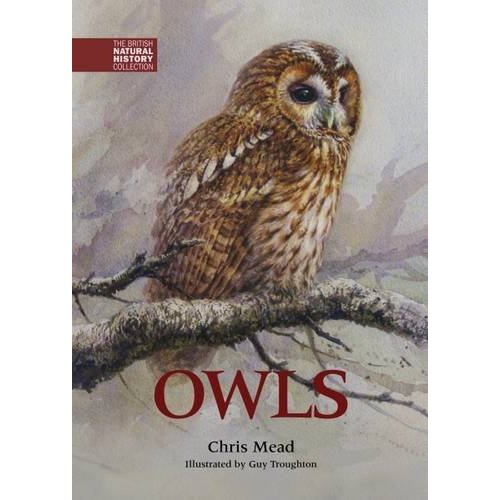Book Review: ‘Owls’ by Chris Mead
- Complaining about the Mainland - 17th August, 2024
- New island designation – is it just greenwash? - 26th April, 2024
- Police and Crime Commissioners – a solution or a problem? - 21st April, 2024
‘Owls’ is the first volume in the new British Natural History Collection from Whittet Books, and it seems very collectable to me.
The first thing you can’t help noticing is that it’s a superbly crafted hardback, just the right size and shape to be carried and read almost anywhere (I wouldn’t trust myself with it near a bath, for example). The paper is good quality, the pages are not just glued but stitched, and the text is cleanly laid out. On almost every page there’s a black-and-white illustration by Guy Troughton, beautiful as well as informative. Perhaps even more incredible, now that editing and proofreading are so endangered, this book provides a safe habitat for them. Of course I may have missed some, but in a book of 138 pages I only found one spelling mistake and four other very minor typos – fewer than you’d find in a single paragraph of most magazines, websites or even books these days. I have to confess that this is the first time I’ve seen this book, but the first edition was published in 1987 (as part of Whittet’s British Natural History Series) and has now been updated by Mike Toms. There are also nine new photographs by Mark Hancox of the five main British breeding species, showing almost every marking on every feather, and including some great action shots. The text lives up to the physical beauty of the book. It concentrates on the British owls – tawny, barn, long-eared, short-eared and little owls – which breed here and number in the thousands. There’s an interesting chapter on estimates of numbers and densities. But there’s also mention of snowy owls, which are counted as British because they bred in Shetland between 1967 and 1975; eagle owls, which have only recently started breeding in very small numbers; and rare visitors from the Continent, Scops owl, hawk owl, and Tengmalm’s owl. These are all put into the European and global context of about 200 owl species worldwide, in 42 bite-sized chapters. They’re a satisfyingly eclectic mixture. Most of the book covers various aspects of owl natural history, but there are also chapters on nest boxes, first aid for injured owls, legal protection, names both scientific and common, and folklore, with the occasional pithy opinion slipped in almost unnoticed. My favourite might be the chapter on pellets, because it gives just the right amount of detail to whet the appetite without overdoing it, and it makes the study of regurgitated semi-digested small furry things sound like good clean fun, something I’ll add to my list of things to do when the mortgage is paid off and the pension’s coming in. There are many insights into owl biology that were new to me. I didn’t know that a higher proportion of barn owls end up as road deaths than any other British bird species. I knew that owl ears were asymmetric to help them pinpoint prey, but I didn’t know that their ears in themselves are only slightly more sensitive than human ears, and it’s the asymmetry and other adaptations such as the facial disc which make their hearing so much better than ours. Nor did I know that it’s only temperate and boreal owls which have superb’ear-sight’, not tropical or sub-tropical species, whose habitats are too noisy for owls to be able to hear their prey. Nor did I know that the fishing owls found in other countries don’t have the soft silent plumage of other owls, again because they don’t catch their prey by hearing. I knew that owl eyesight was also superb, but not that they do actually have some colour vision in daylight. There are answers to where clothes moths are found in the wild, how much time off a day a nesting female owl gets, the reasons for the different levels of aggression shown by different species – something fascinating in every paragraph. The last chapter is on studying owls, and encourages readers to be citizen scientists and contribute to our knowledge and therefore conservation of owls. I’m no birder, so maybe many people will already know all of the many new things which I learnt from this book, but perhaps this book is aimed at people like me – people who appreciate wildlife without knowing as much as we’d like – as much as the real owl enthusiasts. But with such a beautiful book I expect it will be popular with all sorts of people. In his tribute to Chris Mead, who died in 2003, Mike Toms says
Chris Mead combined an extensive, often encyclopaedic, knowledge of birds with a drive to learn more and an infectious enthusiasm. He was also an exceptional communicator, with a strong belief that the findings of scientific work should be shared more widely and not just retained within a narrow community of academics and serious birdwatchers.
That is exactly what’Owls’ does. Chris Mead, Mike Toms Guy Troughton, and Mark Hancox deserve a wide audience for this beautiful book. Owls Chris Mead, updated by Mike Toms with illustrations by Guy Troughton and photographs by Mark Hancox Whittet Books, 2011


Looks like an amazing book. I can’t wait to order it. Thanks for such a comprehensive review. The author should thank you too 🙂